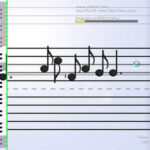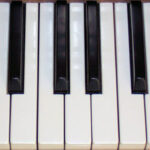Every so often, from out of nowhere, I find that I have a need for a music score editor. Whether it’s because I need to write up an easy arrangement for one of my piano students, or to help out with a choir project at church, my music scoring needs aren’t great, but when they do pop up, I need to be able to sit down with little hassle and produce a score that can be saved, exported, read and printed easily (not to mention I need something that allows me to enter the notes quickly and easily!).
Fortunately, at laest when I was using a Mac every day, there is a free version of Finale (along with Sibelius, considered the gold standard of note entry programs), and I used that. Sure, it had some limitations compared to the full product, but my needs didn’t warrant spending the six hundred dollars required to purchase a full license.
Linux, on the other hand, is not so blessed. Sure, there are score editors here and there, but some (like Lilypad), are a bit too hard for me, to be honest. I prefer a WYSIWYG (what you see is what you get) editor. I want to open it up, enter in which instruments I’ll be using, and then, simply by pointing and clicking, enter in the correct notes.
Thankfully, I just today ran across a program that should meet my needs.
MuseScore is the name of the application, and it is available for both Linux and Windows. While only at version 0.8.0, but I believe it to be complete enough for my limited needs.
When you first open MuseScore, you’ll be greeted with a demo page, with a song already filled in. This gives you a good idea of what MuseScore can accomplish (and I’ve included a screen shot of it as an example). But you, like me, probably just want to get creating, so go to the Score menu and click New. You’ll now be shown a completely blank piece of virtual parchment, with nothing on it. No staves, no measures, no nothing. So we’ll need to create an instrument. All this does is inform MuseScore of what types of instruments will be included. For my use, I select piano and then, once I’m returned to the still-empty score, I need to go to the Create menu, down to Measure, and then to the “Append Measures…” option. This allows me to add a large number of measures all at once. Hit enter, and there they are! Now, to start entering notes, simply click on a rest (so that it turns blue), click what note value you want to use, and start entering.
There are some quirks here, unfortunately. The first time I tried to enter notes, I didn’t realize the “rest” tool was highlighted (as well as the “note” tool), so I was getting rests instead of notes. Also, you may need to click around a bit before you actually start getting notes.
But once you get the hang of things, MuseScore is quite nice to use. Just a quick glance at the tool palette shows off the kind of features available within MuseScore. You can use a variety of clefs, keys, time signatures, bar lines, arpeggios, breath marks, brackets… and more. You can, of course, add a title to your song, along with other text types, such as lyrics, notations and diacritical markings.
When you’re through entering in your notes and editing everything to your liking, MuseScore offers quite a few options for saving your file. If you’ll need the option to go back and edit some more, you can choose the default file format, or any number of XML-based options. You can also export to MIDI (by the way, you can also enter notes via MIDI, if your computer is set up to do that, a feature I was unable to test). One feature I loved was the option to save your score as a PDF file. It only took a second or so, and I had a portable document with crystal-clean, crisp graphics, that could be opened on any computer with Adobe Reader or a similar program. Fantastic!
If you’re used to another notation program (such as Finale or Sibelius), trust me, things will definitely not be what you’re used to. But then, Finale and Sibelius don’t work in exactly the same fashion, just as Microsoft Word is different from Apple’s Pages word processor, which is different from OpenOffice Writer. MuseScore will take some getting used to, but in the end, I think it’s worth it. Depending on your notation needs, MuseScore could save you hundreds of dollars you would otherwise have spent. To give MuseScore a shot, head over to its home page, and check it out.





